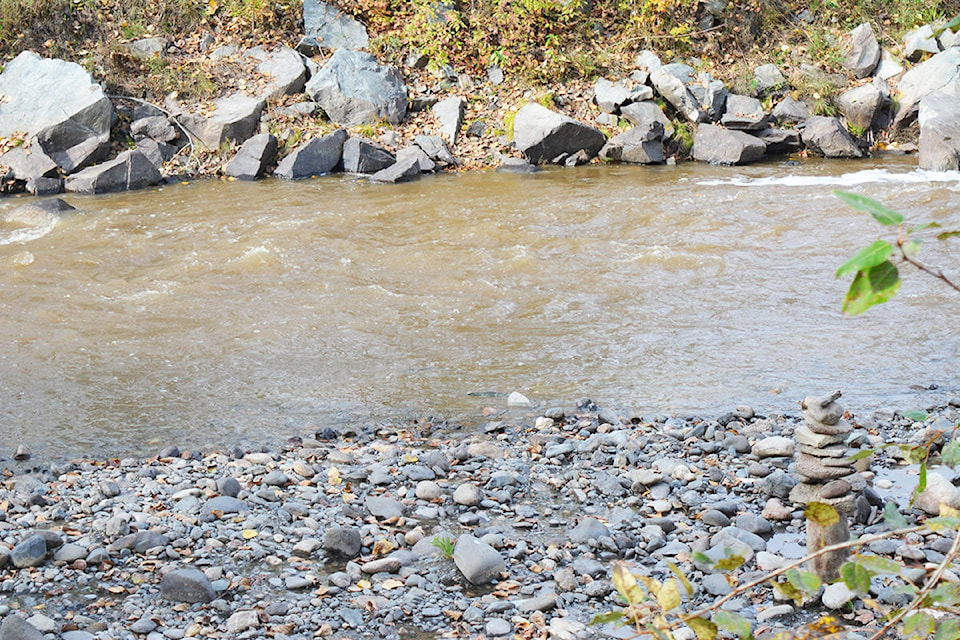It’s spawning time for pink salmon, and the Baker Creek Enhancement Society (BCES) is calling for volunteers for its Pink Salmon Patrol.
“We would like to learn when the peak of spawning is,” said Amanda Vibert, program manager with the BCES. “Traditionally, it’s the end of September to Thanksgiving, but we’re seeing them earlier this year.”
Vibert says Pink Salmon Patrol volunteers can give as much or as little time as they want, walking along Baker Creek and recording how many spawning salmon and how many carcasses they see along the way.
“The purpose of the patrol is to make people aware this is happening here in our own backyard,” said Vibert. “Many people have to travel quite a way to see salmon spawn, so this is incredible that it happens right in our backyard.”
The main patrol area is the lower Baker Creek behind the West Park Mall, near the Skate Park, and anyone who is interested in volunteering for the Pink Salmon Patrol can go to Bosley’s and ask a staff member for a Pink Salmon Patrol clipboard and a high-visibility vest. Once they are done patrolling, they return the clipboard and vest to Bosley’s. Vibert says the patrol will continue until Friday, Oct. 11, and anyone who is interested in patrolling can go straight to Bosley’s or can contact her through the BCES Facebook page.
Vibert started the Pink Salmon Patrol about two weeks ago, and she says some community members had sent her Facebook messages saying they had seen Pinks in Baker Creek two weeks before that.
Vibert says numbers vary quite a bit, and they don’t really have a good benchmark yet, as the last time they did a Pink Salmon Patrol was in 2015.
Pink salmon have a life cycle of two years, and they are born in fresh water like Baker Creek, explained Vibert. The salmon swim to the ocean to grow as adults, then return to the fresh water where they were born to spawn.
“In our area, they spawn in odd-numbered years,” said Vibert. “Up north, such as in Alaska, they spawn in even years, and the two populations are very distinct. It’s amazing.”
All salmon die after they spawn, and Pink Salmon Patrol volunteers will likely see carcasses as they walk along Baker Creek.
“With their carcasses, when they migrate from the ocean, they bring nutrients from the ocean to the Interior,” explained Vibert. “Other animals feed off the carcasses, and the nutrients feed the plants. They are very connected.”
Sally Hofmeier is a Pink Salmon Patrol volunteer, and she says she became involved because she is interested in anything to do with nature.
“It’s always interesting to see a phenomena like that where it’s such a complicated life cycle, and they are using different habitats,” she said. “I am interested in the salmon life cycle — it is one of the most complex life cycles — and the recycling of nutrients. The salmon’s nutrients feed the bears, and the bears feed the forests.”
When Pink salmon are ready to spawn, the males will develop a hump on their back, and they develop a very hooked jaw, said Vibert, noting the females change too, but it isn’t as noticeable. Vibert says that if someone is on patrol and looking for a spawner, they would look for that hump in the male, as well as movement in the water.
Hofmeier says she also usually sees four or five salmon swimming together.
“Very rarely have I seen a single one,” she said.
Vibert says the salmon need gravel for spawning, as the female will dig a redd with her tail, and then the male and female hover over that redd and release eggs and milt.
Vibert says at this critical spawning time, it is important to keep animals and people out of the creek because they could squish the salmon eggs.
Once the salmon eggs hatch, Vibert says with pinks, as soon as the eggs hatch, they go right to the ocean; whereas, with chinooks, the eggs will stay in Baker Creek for a year or two and then go to the ocean.
This year, the BCES has collected pink salmon eggs from Williams Lake to be part of its Stream to Sea Salmonids in the Classroom program. Eight tanks will be placed at eight schools in the community, and students will raise the salmon eggs over the winter and release them in the spring.
“We historically do chinook, but this year, we will do pinks because of the low chinook numbers,” said Vibert. “We were hoping to collect chinook eggs from Nazko, but there weren’t enough.”
For updates from BCES and the Pink Salmon Patrol, visit the Baker Creek Enhancement Society’s Facebook page.
READ MORE: VIDEO: Drone footage documents work to free salmon at Big Bar landslide
editor@quesnelobserver.com
Like us on Facebook and follow us on Twitter
